I bought two nicely designed DIY PA Mid-High units which had served for a long time, both equipped with two Beyma CP22, and one EV1824M each, so six drivers all in all. 4 of these drivers were ok. Instead, both Beyma CP22 of one and the same cabinet had broken aluminium membranes. Broken membranes in a very strange way to me. They are broken into in a lot of small aluminium flakes.
Both these two broken drivers stilll sound somehow (one expectedly flawed and the other quite miserably) when fed e.g. with white noise, so their voice coil is still intact, at approx. measured 7 Ohms. It seems strange to me that it's the inner part of the membrane which is badly "flaked", e.g. central to the voice coil, while the outer part of the membrane, e.g. peripheral from the voice coil, is ok less one spot on one driver where there is a single hole in it. The membranes are broken in kind of a "flaky" way. Very strange to me. Many of these mini aluminium flakes had then migrated to the periphery of the membrane where they got stuck on some glue leftovers.
The central parts of the flaked membrane is the part which is located under the central phase plug. Inside this phase plug, I discovered some quite sharp leftovers from the manufacturing process.
Can you help me to understand what happened to these two "flaked" tweeters?
Intact sample
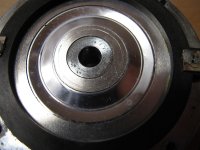
Flaked samples
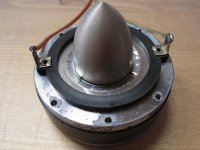
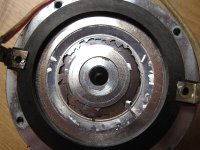
The one with the single hole in the outer section
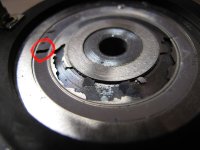
One sample of a sharp manufacturing leftover under the phase plug
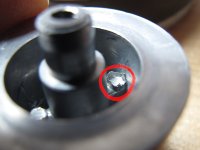
Both these two broken drivers stilll sound somehow (one expectedly flawed and the other quite miserably) when fed e.g. with white noise, so their voice coil is still intact, at approx. measured 7 Ohms. It seems strange to me that it's the inner part of the membrane which is badly "flaked", e.g. central to the voice coil, while the outer part of the membrane, e.g. peripheral from the voice coil, is ok less one spot on one driver where there is a single hole in it. The membranes are broken in kind of a "flaky" way. Very strange to me. Many of these mini aluminium flakes had then migrated to the periphery of the membrane where they got stuck on some glue leftovers.
The central parts of the flaked membrane is the part which is located under the central phase plug. Inside this phase plug, I discovered some quite sharp leftovers from the manufacturing process.
Can you help me to understand what happened to these two "flaked" tweeters?
Intact sample

Flaked samples


The one with the single hole in the outer section

One sample of a sharp manufacturing leftover under the phase plug

Last edited:
I suppose those tweeters were crossed way too low and driven past mechanical limit for a continued time. There is no evidence of corrosion, nor any signs of eversion from a single large DC pulse. Inner part of the diaphragm probably has more air load from the phase plug, so it received 99% of the damage.
Yes, and thank you for your anwer! Your and other feedback converge to this overstress hypothesis: Meanwhile I also sent this documentation to Beyma and asked a machine engineer and specialist for vibrational issues. Most probable: Too much membrane stress over a longer time, maybe also even with the membrane touching the phase plug, which might have lead to an initial small rip/puncture. From this weak point then, the ripping succeedingly spreaded to all directions during further use. Beyma told me they have sold "dozens of thousands" of such units and had never seen such a failure before. As for me, I never thought that an aluminium membrane could fall apat like this.
About this twofold membrane fail within one single box: I have to say about the pre-story that I did not take care about the wiring of these cabinets as I was disassembling them. Maybe in the concerned unit with the two damaged tweeters the connection for the tweeter and the mid at the xover board might have been historically interchanged by an ingenious "service" man. Then, at the next gig, very strangely these devices did not sound any longer as they should have. This might be why they were stored away some unsuccessful gigs later: The pre-owner of these units told me that he had long not used these units any more. And he was sorry for not having tested them prior to selling them away.
About this twofold membrane fail within one single box: I have to say about the pre-story that I did not take care about the wiring of these cabinets as I was disassembling them. Maybe in the concerned unit with the two damaged tweeters the connection for the tweeter and the mid at the xover board might have been historically interchanged by an ingenious "service" man. Then, at the next gig, very strangely these devices did not sound any longer as they should have. This might be why they were stored away some unsuccessful gigs later: The pre-owner of these units told me that he had long not used these units any more. And he was sorry for not having tested them prior to selling them away.
Over excursion, and/or work hardened aluminium diaphragms.
The bad machining is sadly common with these Beyma 'super tweeters.
The bad machining is sadly common with these Beyma 'super tweeters.
Any further references for this one? Besides of this, the two functional items show a very neat match, and this over many years of use. So CP22 seem fine altogether, especially in aging, if not misused.

Both measurements are free field measured at approx. 50cm from mouth, naked items without any baffle.
Both measurements are free field measured at approx. 50cm from mouth, naked items without any baffle.